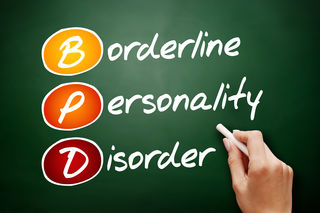Personality
Three Steps to Identifying a Borderline Personality
Recognizing this personality can help manage relationships and choices.
Posted July 1, 2019 Reviewed by Gary Drevitch
Whether you are close to someone with a borderline personality disorder (BPD) or wonder whether you have the disorder yourself, there is a 3-step method that can be helpful in recognizing it. I call it the WEB Method® which stands for: their Words, your Emotions, and their Behavior. (For more, see my book, 5 Types of People.) By recognizing this personality in your life, you can adapt how you interact with the person to be more effective, have more realistic expectations, and make more informed decisions about whether to maintain or leave the relationship.

It’s important to know that you cannot change someone else’s personality, but you may be able to manage the relationship. This is especially important to know if you have a family member or other close person who will be remaining in your life despite their difficult behavior.
It also helps to know that there are effective treatments for BPD, so that those who are motivated to change have a way out of the chaotic and self-defeating behaviors that may plague their (or your) life. Using cognitive-behavioral therapy methods such as DBT (Dialectical Behavior Therapy), some people have outgrown the diagnosis of borderline personality disorder by learning skills of self-management, distress tolerance, and how to have happy relationships.
The Theme of Fear of Abandonment
Underlying most of the difficult behaviors of someone with a borderline personality is the fear of abandonment in close relationships. These behaviors range from clinging (lots of phone calls, text messages, showing up by surprise) to manipulation to keep a relationship (lying, saying that someone else is angry at you, pretending to be pregnant, suicidal threats or gestures) to full-on rage at possible abandonment (verbal criticism, spreading rumors on the internet, sometimes physical abuse). Managing emotions can be difficult for the person, as intense emotions often take over and can be quite disproportionate to the situation. They also tend to see others in extreme terms: "all good" or "all bad."
Many, but not all, of those with this disorder are also high-conflict people, meaning that they are preoccupied with blaming others and may seek revenge and vindication against them when their targets often have done nothing wrong. The fixation on attacking others is what stands out for some of those with this most difficult combination of borderline personality and high-conflict personality. People with BPD represent approximately 6 percent of the population and may be men or women.1
Here are the 3 steps to consider:
Their WORDS
They can be the life of the party and appear to be very popular and attractive. Their words can be extremely seductive, soothing, and exciting, alternating with extreme criticism, anger, and rage.
Extremely positive words: Whether you meet as friends, co-workers, or dating partners, they will seek a fast commitment—faster than most—to a close relationship to help them feel secure that you will never leave them. Very quickly they may reveal: I can’t get you out of my head! I feel that we are soul mates, made to be together forever! You’re the most wonderful person I’ve ever met! You’re my dream come true! Let’s get married!
This could occur within the first few days of meeting. And this is not to say that these words are only said by those with BPD, but one should be cautious if the intensity and speed of hearing these words is surprising. They tend to lack emotional boundaries, so that the ordinary restraint of step-by-step getting-to-know-you that most people have in new relationships may be missing. They tend to idealize people who are simply being nice to them.
Extremely negative words: At some point, usually soon after you get closer, the person will switch to intense criticism and rage, often over something minor or non-existent, like simply being friendly to someone else: How could you treat me so badly! How insensitive! You must have known how this would hurt me! You are the worst person I have ever met! I’m going to tell everyone how awful you really are! You betrayed me and showed me how truly evil you really are! You need to face the truth about yourself! They may write to you in all caps, bold and underlined.
... and extremely positive again: People with BPD have wide mood swings, between extreme loving and friendliness, and extreme anger and hatefulness. This could occur within minutes of each other and over days and weeks, especially in an effort to win you back: I am so sorry I got so angry at you. I will make it up to you. Please, please, please let me explain. If you will only meet with me to discuss what happened, I will pour my heart out to you and show you that this will never happen again. Remember how you said that people should treat me nicer, given my history. I’m counting on you to be that kind of person. You’re the only person who really understands.
Your EMOTIONS
Recognizing how you are feeling is a surprisingly helpful way of realizing when you’re dealing with someone with BPD.
Walking on eggshells: If you feel that you are walking on eggshells and fearful of triggering the person’s rage, that’s often a warning sign. (In fact, there’s a good book about this with that title: Stop Walking on Eggshells by Mason and Kreger.) You may feel jerked around, like you’re on a swing, back and forth from really exciting and loving to really frightening and the target of a hate campaign. You may feel like you’re going crazy because it's obvious to you that the BPD person is acting badly, but he or she says its really you who is acting badly. You start questioning yourself.
Sex and infatuation: These can happen quickly with someone with BPD. It’s easy to fall in love with them, because they can be so charming, exciting, and affectionate. They can make you feel really special. But this is one side of a two-sided coin. The other is the anger, resentment, and potential abuse. Beware the rush to make any big commitments based on infatuation. It’s better to wait a year, to see if there is a high-conflict pattern beneath the surface. (See my book Dating Radar with co-author Megan Hunter for more.)
Their BEHAVIOR (The 90% Rule)
The primary pattern of those with BPD is intense mood swings. Emotion dysregulation is a hallmark of the disorder. These will usually catch you by surprise, as they can be disproportionate to the situation, with fast positive close behavior shifting to fast criticism and anger. When this first happens, many people are shocked but then chalk it up to a one-time bizarre moment. In reality, those with BPD may have a pattern of these mood swings and they usually will continue on a regular basis.
They are also capable of extreme behavior that 90% of people would never do, such as screaming at you in public, suddenly running out of a meeting, physically assaulting you, breaking a favorite object, checking up on you at work, spreading false rumors about you online, making up stories about you to get you into trouble with other important people in your life, and so forth. Keep in mind that all of these behaviors can occur in a dating relationship, as friends at work, as neighbors, or otherwise. It can be quite shocking.
Targets of Blame: If they also have a high-conflict personality, then their solution to most of their problems is to attack a Target of Blame—usually someone close to them. This can switch at any time to new targets and include anyone who doesn’t support them in their blame of their other targets. Just trying to set limits with them (“I can’t get together this weekend.” Or: “We need to slow this down. You’re getting too intense for me.”) can trigger their intense blaming behavior toward you. With this in mind, it can help to keep a calm mood when delivering bad news and avoid blaming him or her. Instead, focus on the future and choices they can make now.
Conclusion
People with BPD can surprise you with their negative feedback and emotional confrontations. By recognizing this as a pattern of behavior, you will realize that many of their emotions are beyond their conscious control and will, therefore, repeat and repeat, unless they are working on changing these behaviors. Promises to change are easy to make but hard to keep. It takes lots of practice to change a single behavior, let alone a pattern. Yet some people with BPD successfully overcome the diagnosis.
If you recognize yourself in the patterns described here, it’s good to know that you can learn to change in many situations. Cognitive-behavioral therapy (CBT) is the most common approach to learning new skills of self-management. Finding a program or a therapist who combines counseling with skills training can be very helpful. “Cognitive” means helping you challenge and change your negative thoughts. “Behavioral” means helping you try new behaviors that work better. Dialectical Behavior Therapy (DBT) is one type of CBT which includes finding a more realistic balance in most situations rather than seeing them in all-or-nothing terms. It can be very encouraging to read detailed stories of recovery from BPD (such as The Big Book of Borderline Personality Disorder by Shehrina Rooney).
For those close to someone with BPD, using the WEB Method® to recognize patterns of their Words, your Emotions, and their Behavior can help you adapt your approach to them, so that you are not trying to give them insight into themselves or trying to be their therapist. Instead talk about the future and what to do now, without taking responsibility for their actions or reactions to you. Think in terms of what you need to manage the relationship or to move on in your life. Learning these patterns can help you to be less likely to trigger an unnecessary confrontation and more likely to find a balance that works for you.
References
1. American Psychiatric Association: Diagnostic and Statistical Manual of Mental Disorders, Fifth Edition. Arlington, VA, American Psychiatric Association, 2013, 665.




